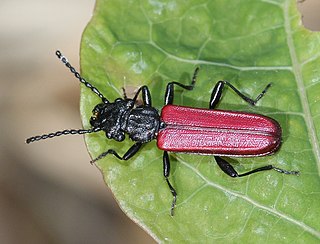
Convolvulaceae, known commonly as the bindweed or morning glory family, is a family of about 60 genera and more than 1,650 species of mostly herbaceous vines, but also trees, shrubs and herbs, and also including the sweet potato and a few other food tubers.

Diplacodes is a genus of dragonflies in the Libellulidae family. They are commonly known as perchers. Their colours range from the totally black body of the African Diplacodes lefebvrii, the lovely pale blue of India's Diplacodes trivialis, to the intense red of the Asian–Australian Diplacodes haematodes.

Diplacodes haematodes, the scarlet percher, is a species of dragonfly in the family Libellulidae. It occurs throughout Australia, Timor, New Guinea, Vanuatu, and New Caledonia. It is locally common in habitats with hot sunny exposed sites at or near rivers, streams, ponds, and lakes. It often prefers to settle on hot rocks rather than twigs or leaves, and is quite wary. This is a spectacular species of dragonfly, although small in size. The male is brilliant red, the female yellow-ochre. Females have yellow infuscation suffusing the outer wings, while the males have similar colour at the bases of the wings.

Salvia pratensis, the meadow clary or meadow sage, is a species of flowering plant in the family Lamiaceae, native to Europe, western Asia and northern Africa. The specific epithet pratensis refers to its tendency to grow in meadows. It also grows in scrub edges and woodland borders.

Cucujus is a genus of beetles in the family Cucujidae, the flat bark beetles. It contains 19 currently recognized species and subspecies.
Gaedioxenis is a genus of parasitic flies in the family Tachinidae. There are at least four described species in Gaedioxenis.
Anthene flavomaculatus, the yellow-spot ciliate blue, is a butterfly in the family Lycaenidae. It is found in Nigeria, Cameroon and northern Angola. The habitat consist of forests.

Rhododendron haematodes (似血杜鹃) is a rhododendron species native to northeastern Myanmar, and southeastern Xizang and western Yunnan in China, where it grows at altitudes of 3100–4000 meters. It is a shrub that grows to 1.5–3 m in height, with leathery leaves that are oblong to obovate, 2.7–7.5 by 0.7–3.2 cm in size. Flowers are red.

Psallus haematodes is a true bug. The species is found in the Palearctic.It occurs almost everywhere in Europe, but only occurs in the north of the Mediterranean. East the range extends to Siberia and to the Caspian region. It is introduced in North America. It is found in open, sunny, but also shady places on wetland edges, rivers and in bogs, and also in dry habitats.

Tibicina haematodes is a species of cicadas belonging to the family Cicadidae, subfamily Tibicininae.

Pycnomerus sulcicollis is a species of ironclad beetle in the family Zopheridae. It is found in North America.

Pycnomerus is a genus of ironclad beetles in the family Zopheridae. There are more than 20 described species in Pycnomerus.
Milesia scutellata is a species of syrphid fly in the family Syrphidae.
Pachybrachis haematodes, the bloody pachy, is a species of case-bearing leaf beetle in the family Chrysomelidae. It is found in Central America and North America.
Chrysotoxum chinook is a species of syrphid fly in the family Syrphidae.
Sphecomyia nasica is a species of syrphid fly in the family Syrphidae.
Spilomyia liturata is a species of syrphid fly in the family Syrphidae.
Pycnomerus thrinax is a species of ironclad beetle in the family Zopheridae. It is found in North America.
Pycnomerus reflexus is a species of ironclad beetle in the family Zopheridae. It is found in North America.
Animal Ethics is a nonprofit organization formed to promote discussion and debate around issues in animal ethics and to provide information and resources for animal advocates. They also do outreach work in several countries on the issue of speciesism. Their aim is to create a world where moral consideration is extended to all sentient beings. The organization's website covers topics such as speciesism, sentience, veganism and wild animal suffering and has content translated into several languages.








